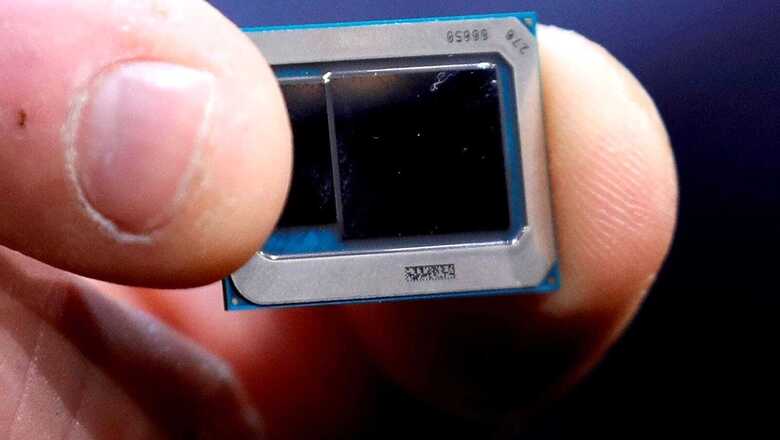
views
On the one hand, semiconductors have transformed the way the global automotive industry functions by adding technology to a core mechanical product like cars and on the other hand, the dependency on these chips have now made the industry to come to a screeching halt as the production of these semiconductors fall short. We got in touch with Sanjay Gupta, Vice President & India Country Manager, NXP Semiconductors to understand the importance of chips in automobiles and the road ahead.
Q.Tell us about NXP and its auto related technologies
Q.NXP Semiconductors is one of the world’s leading semiconductor manufacturers. With more than 2500 engineers, NXP runs four R&D centres in India (Noida, Pune, Bangalore & Hyderabad) that are involved in development of semiconductor hardware and software designs across various verticals – Automotive (connected cars), digital payments (NFC enabled), 5G (RF solutions) and many more.
NXP has been driving innovation in the secure connected vehicles, end-to-end security & privacy and smart connected solutions markets. It has also long supplied chips to the automotive industry and has deep ties in the industry. The Indian automotive industry is seeing rapid transformation and growth, mainly driven by increasing disposable income, shifted focus on new forms like EVs, and infrastructure development.
There are a plethora of technologies that are part of today’s cars. NXP majorly focuses on three domains in the automotive space: Electrification (Power Train management & Battery management), Autonomous & Advanced Driver Assistance System (Radar & Safe processing), and finally In-Car Experience (connected infotainment, User Audio & Video Interface and secure mobile car access).
Electrification (Power Train management & Battery management)
NXP provides solutions that deliver optimal performance, strong functional safety, and power management required for the next generation of electric and hybrid vehicles. Key elements under Electrification are Hybrid electric vehicle converter and charger, Battery management system and Diesel Engine management.
Autonomous & Advanced Driver Assistance System (Radar & Safe processing)
Sensing is a key element for an effective Advanced driver-assistance system (ADAS) and the self-driving, autonomous car. By equipping cars with state-of-the-art eyes and ears, securely connected both internally within the car and externally to transport infrastructures, NXP is helping make this a reality.. Key areas under ADAS system are Automotive radar, Vision systems, Vehicle-to-vehicle (V2V), V2X communication.
In-Car Experience (connected infotainment, User Audio & Video Interface and secure mobile car access).
With NXP technology, the Automotive Internet of Tomorrow (IoT) connects the car to the outside world in a secured manner to share information that will enhance and transform our driving experience. Cars can interact with each other and the infrastructure through v2x technology enabling better traffic management and create a free flowing, safe road environment.
Q.NXP’s role around EV development
Concerns about carbon emissions, regulatory compliance, and rising energy costs are driving up demand for electric vehicles. Consumer knowledge of environmental issues has also helped to boost the industry and open new opportunities for automakers.
NXP is playing a pivotal role in the journey of electric mobility and has successfully tested solutions which have worked globally. We are not only developing system solutions for electric vehicles in battery and power train management, but we are also enabling the charging infrastructure. EVs are unquestionably better for the environment than their petrol and diesel counterparts, but they might pose an issue for motorists if the proper charging infrastructure is not in place owing to mileage anxiety. This is where companies like ours play a critical role.
Tomorrow, if a driver needs to charge battery, he will be able to acquire information to the nearest charging station by simply looking at his or her phone or the car, as both (EV and charging station) will be equipped with smart connected technology.
Semiconductors will oversee the increase in the interface between the driver, the cloud, electric vehicle batteries, and power train components to ensure improved communication. They will make an electric vehicle smarter, more connected, secure, and safer. Government of India’s robust plans and focus on Electric Vehicles will drastically change the face of the Indian automobile Industry in years to come.
This is first yet a vital step towards realizing the dream of a pollution-free environment. Indian electric vehicle market is likely to reach US$ 50 billion by 2030 principally spurred by government schemes and growing environmental concerns. Several incentives, such as rebate in taxes, grants and subsidies, have been extended by the central and state governments in order to increase electric vehicle adoption in the country.
Though government has introduced various schemes under National Electric Mobility Mission Plan (NEMMP) such as Faster Adoption and Manufacturing of (Hybrid &) Electric Vehicles (FAME 1&2) scheme, challenges like feasible charging infrastructure, high cost, long range anxiety still remain. We need to address these in order to achieve this mission.
Q.How do you see the overall EV market of India?
With deteriorating air quality in India, Electric vehicles (EVs) have become the need of the hour. Along with ensuring a clean environment-friendly mobility system in the future, the EV penetration in India is expected to create huge employment opportunities. According to a report by IESA, EV market is expected to grow at a CAGR of 36% till 2026. However, there are multiple factors that are going to define the adoption of EVs.
While we are assisting in the development of EV systems, we are also fully aware of the obstacles and opportunities that the adoption of EVs in India will bring. Introduction of schemes like Faster Adoption and Manufacturing of (Hybrid &) Electric Vehicles (FAME 1&2) under National Electric Mobility Mission Plan (NEMMP) will give boost to faster adoption of electric vehicles in India.
Government subsidies will reduce the cost of EVS, but the primary worry remains the battery’s viability. There could be ‘charging zones,’ which would be put up in public places with a cashless transaction mechanism, ensuring better last-mile connectivity. Until the infrastructure is in place, swapping batteries could be a quick fix.
NXP’s strategy for 2021 and beyond
Over the next few years, we will continue to emphasise on strengthening our R&D capabilities, as India is one of NXP’s largest design centres, with teams across India sites (Noida, Bangalore, Hyderabad, and Pune) performing critical hardware and software R&D activities that are critical for global customer projects running in India in collaboration with other design centres across the world.
Currently, NXP India is among the biggest Design Centres in the world and our teams in India have developed and incubated various hardware and software solutions for our global clients across various verticals such as Automotive (connected cars), digital payments (NFC enabled), 5G (RF solutions) and more.
Our proficiency in security, built through decades of regular and deep investment, makes us a valuable and reliable partner when our clients are deciding the security requirements for projects. NXP helps build reliable, secure and trusted solutions for financial institutions, retailers, and governments that depend on secure embedded systems. From MCUs to processors, to secure elements, to software and services—NXP provides solutions for built-in protection.
In the last a few years, we’ve grown our operations in India to become a team of professional engineers dedicated to scale up the value chain and become an integral component of our worldwide network of design teams, which is at the heart of our business. We are a major security technology provider here for a variety of applications ranging from connected automobiles to data centres, healthcare to industrial control.
Furthermore, we will continue to give impetus and support government’s initiatives – like Make in India, Digital India and Start-up India by helping to build a robust ecosystem of start-ups working in the semiconductor and IP design space across the country. We would direct our efforts in the direction of helping India’s vision of becoming a global semiconductor hub and increasing our country’s electronics manufacturing to USD 400 billion by the year 2025.
Q.How do you see autonomous vehicles in India?
There was a time when there were doubts about the practicality of autonomous vehicles in India, particularly given the lack of infrastructure and unfavourable legislation. However, things appear to be changing quickly. India is currently at Level 2 of the autonomous vehicle market where we have technologies such as smart collision detection, lane departure and cruise control.
We believe that India should first focus on ADAS features (level 1-3) to avoid accidents and save human life and then eventually reach to Level 5, which would imply, ‘no steering wheels’ and full automation. Over the last many years, plenty of ADAS features such as reverse park assist, cruise control, blind-spot detection, and automatic pedestrian detection have made their presence into cars in the US and Europe but have made their inroads in India only a few years back.
Majority of the automotive accidents which take place in this country are generally due to some form of human error which could be either due to poor recognition or poor judgment on part of the driver. Hence, automation in this sector using advanced fool-proof electronics systems could prove very vital for saving thousands of innocent lives who die in road accidents.
A strong government push is required for ADAS to become a mass-market product. However, there are host of challenges for adoption of ADAS in India but over a period of time, we will see the transition taking place. We anticipate that the ADAS market in India will see a double-digit growth.
Read all the Latest News, Breaking News and Assembly Elections Live Updates here.




















Comments
0 comment